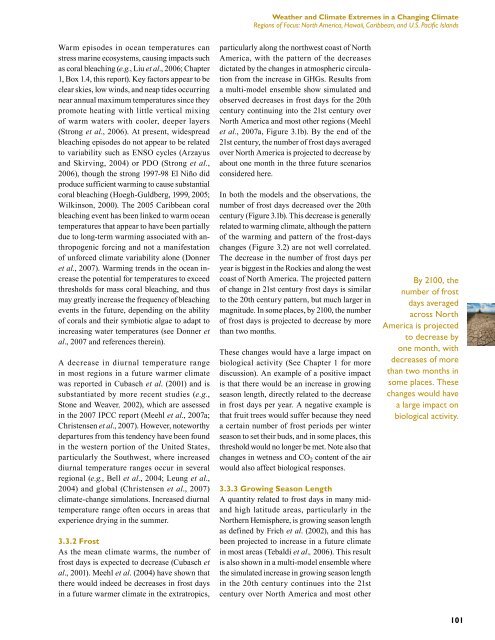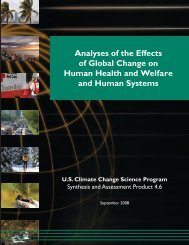Weather and Climate Extremes in a Changing Climate. Regions of ...
Weather and Climate Extremes in a Changing Climate. Regions of ...
Weather and Climate Extremes in a Changing Climate. Regions of ...
Create successful ePaper yourself
Turn your PDF publications into a flip-book with our unique Google optimized e-Paper software.
Warm episodes <strong>in</strong> ocean temperatures can<br />
stress mar<strong>in</strong>e ecosystems, caus<strong>in</strong>g impacts such<br />
as coral bleach<strong>in</strong>g (e.g., Liu et al., 2006; Chapter<br />
1, Box 1.4, this report). Key factors appear to be<br />
clear skies, low w<strong>in</strong>ds, <strong>and</strong> neap tides occurr<strong>in</strong>g<br />
near annual maximum temperatures s<strong>in</strong>ce they<br />
promote heat<strong>in</strong>g with little vertical mix<strong>in</strong>g<br />
<strong>of</strong> warm waters with cooler, deeper layers<br />
(Strong et al., 2006). At present, widespread<br />
bleach<strong>in</strong>g episodes do not appear to be related<br />
to variability such as ENSO cycles (Arzayus<br />
<strong>and</strong> Skirv<strong>in</strong>g, 2004) or PDO (Strong et al.,<br />
2006), though the strong 1997-98 El Niño did<br />
produce sufficient warm<strong>in</strong>g to cause substantial<br />
coral bleach<strong>in</strong>g (Hoegh-Guldberg, 1999, 2005;<br />
Wilk<strong>in</strong>son, 2000). The 2005 Caribbean coral<br />
bleach<strong>in</strong>g event has been l<strong>in</strong>ked to warm ocean<br />
temperatures that appear to have been partially<br />
due to long-term warm<strong>in</strong>g associated with anthropogenic<br />
forc<strong>in</strong>g <strong>and</strong> not a manifestation<br />
<strong>of</strong> unforced climate variability alone (Donner<br />
et al., 2007). Warm<strong>in</strong>g trends <strong>in</strong> the ocean <strong>in</strong>crease<br />
the potential for temperatures to exceed<br />
thresholds for mass coral bleach<strong>in</strong>g, <strong>and</strong> thus<br />
may greatly <strong>in</strong>crease the frequency <strong>of</strong> bleach<strong>in</strong>g<br />
events <strong>in</strong> the future, depend<strong>in</strong>g on the ability<br />
<strong>of</strong> corals <strong>and</strong> their symbiotic algae to adapt to<br />
<strong>in</strong>creas<strong>in</strong>g water temperatures (see Donner et<br />
al., 2007 <strong>and</strong> references there<strong>in</strong>).<br />
A decrease <strong>in</strong> diurnal temperature range<br />
<strong>in</strong> most regions <strong>in</strong> a future warmer climate<br />
was reported <strong>in</strong> Cubasch et al. (2001) <strong>and</strong> is<br />
substantiated by more recent studies (e.g.,<br />
Stone <strong>and</strong> Weaver, 2002), which are assessed<br />
<strong>in</strong> the 2007 IPCC report (Meehl et al., 2007a;<br />
Christensen et al., 2007). However, noteworthy<br />
departures from this tendency have been found<br />
<strong>in</strong> the western portion <strong>of</strong> the United States,<br />
particularly the Southwest, where <strong>in</strong>creased<br />
diurnal temperature ranges occur <strong>in</strong> several<br />
regional (e.g., Bell et al., 2004; Leung et al.,<br />
2004) <strong>and</strong> global (Christensen et al., 2007)<br />
climate-change simulations. Increased diurnal<br />
temperature range <strong>of</strong>ten occurs <strong>in</strong> areas that<br />
experience dry<strong>in</strong>g <strong>in</strong> the summer.<br />
3.3.2 Frost<br />
As the mean climate warms, the number <strong>of</strong><br />
frost days is expected to decrease (Cubasch et<br />
al., 2001). Meehl et al. (2004) have shown that<br />
there would <strong>in</strong>deed be decreases <strong>in</strong> frost days<br />
<strong>in</strong> a future warmer climate <strong>in</strong> the extratropics,<br />
<strong>Weather</strong> <strong>and</strong> <strong>Climate</strong> <strong>Extremes</strong> <strong>in</strong> a Chang<strong>in</strong>g <strong>Climate</strong><br />
<strong>Regions</strong> <strong>of</strong> Focus: North America, Hawaii, Caribbean, <strong>and</strong> U.S. Pacific Isl<strong>and</strong>s<br />
particularly along the northwest coast <strong>of</strong> North<br />
America, with the pattern <strong>of</strong> the decreases<br />
dictated by the changes <strong>in</strong> atmospheric circulation<br />
from the <strong>in</strong>crease <strong>in</strong> GHGs. Results from<br />
a multi-model ensemble show simulated <strong>and</strong><br />
observed decreases <strong>in</strong> frost days for the 20th<br />
century cont<strong>in</strong>u<strong>in</strong>g <strong>in</strong>to the 21st century over<br />
North America <strong>and</strong> most other regions (Meehl<br />
et al., 2007a, Figure 3.1b). By the end <strong>of</strong> the<br />
21st century, the number <strong>of</strong> frost days averaged<br />
over North America is projected to decrease by<br />
about one month <strong>in</strong> the three future scenarios<br />
considered here.<br />
In both the models <strong>and</strong> the observations, the<br />
number <strong>of</strong> frost days decreased over the 20th<br />
century (Figure 3.1b). This decrease is generally<br />
related to warm<strong>in</strong>g climate, although the pattern<br />
<strong>of</strong> the warm<strong>in</strong>g <strong>and</strong> pattern <strong>of</strong> the frost-days<br />
changes (Figure 3.2) are not well correlated.<br />
The decrease <strong>in</strong> the number <strong>of</strong> frost days per<br />
year is biggest <strong>in</strong> the Rockies <strong>and</strong> along the west<br />
coast <strong>of</strong> North America. The projected pattern<br />
<strong>of</strong> change <strong>in</strong> 21st century frost days is similar<br />
to the 20th century pattern, but much larger <strong>in</strong><br />
magnitude. In some places, by 2100, the number<br />
<strong>of</strong> frost days is projected to decrease by more<br />
than two months.<br />
These changes would have a large impact on<br />
biological activity (See Chapter 1 for more<br />
discussion). An example <strong>of</strong> a positive impact<br />
is that there would be an <strong>in</strong>crease <strong>in</strong> grow<strong>in</strong>g<br />
season length, directly related to the decrease<br />
<strong>in</strong> frost days per year. A negative example is<br />
that fruit trees would suffer because they need<br />
a certa<strong>in</strong> number <strong>of</strong> frost periods per w<strong>in</strong>ter<br />
season to set their buds, <strong>and</strong> <strong>in</strong> some places, this<br />
threshold would no longer be met. Note also that<br />
changes <strong>in</strong> wetness <strong>and</strong> CO 2 content <strong>of</strong> the air<br />
would also affect biological responses.<br />
3.3.3 Grow<strong>in</strong>g Season Length<br />
A quantity related to frost days <strong>in</strong> many mid-<br />
<strong>and</strong> high latitude areas, particularly <strong>in</strong> the<br />
Northern Hemisphere, is grow<strong>in</strong>g season length<br />
as def<strong>in</strong>ed by Frich et al. (2002), <strong>and</strong> this has<br />
been projected to <strong>in</strong>crease <strong>in</strong> a future climate<br />
<strong>in</strong> most areas (Tebaldi et al., 2006). This result<br />
is also shown <strong>in</strong> a multi-model ensemble where<br />
the simulated <strong>in</strong>crease <strong>in</strong> grow<strong>in</strong>g season length<br />
<strong>in</strong> the 20th century cont<strong>in</strong>ues <strong>in</strong>to the 21st<br />
century over North America <strong>and</strong> most other<br />
By 2100, the<br />
number <strong>of</strong> frost<br />
days averaged<br />
across North<br />
America is projected<br />
to decrease by<br />
one month, with<br />
decreases <strong>of</strong> more<br />
than two months <strong>in</strong><br />
some places. These<br />
changes would have<br />
a large impact on<br />
biological activity.<br />
101




